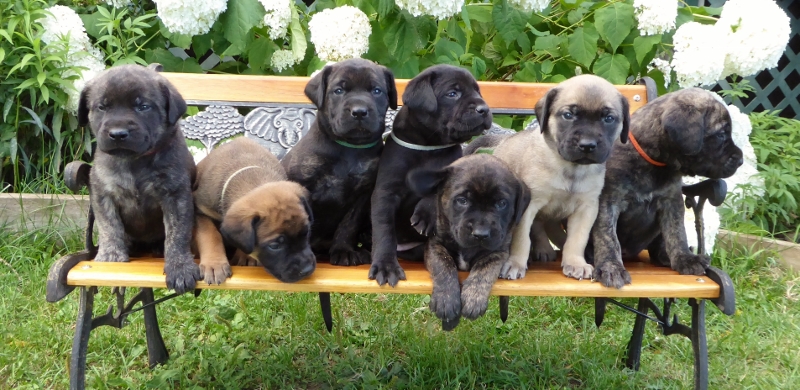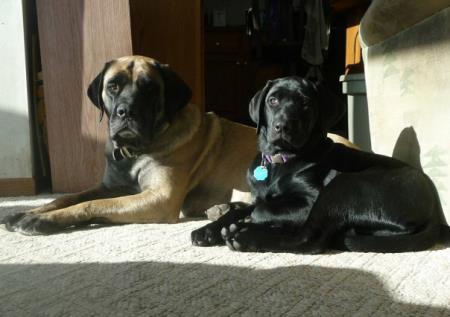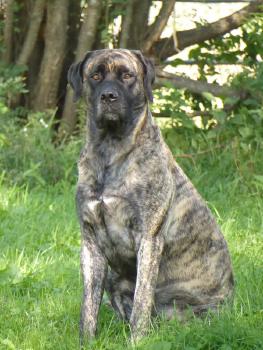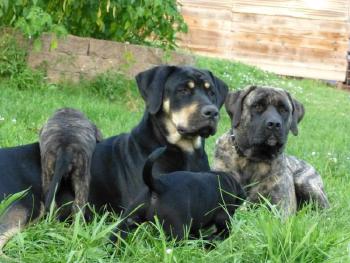 | ||||||
THE MASTADOR
The Hybrid Cross of the English Mastiff & the Labrador Retriever
To understand the Mastador it is helpful to first learn a little bit about the Labrador Retriever and English Mastiff.
Labrador Retrievers
Outgoing, Agile, Very Intelligent, Trusting, Even Tempered, Loving, Gentle, Kind, Smart, Easy to train, Soft mouth, Highly sensitive, Very Loyal, Affectionate, Friendly with family, kids, dogs, strangers, People-oriented dogs who live to serve their families. The U.S. Number 1 ranking popular dog breed every year since 1991.
Labs are easy to recognize. Sturdy and well-balanced. Depending on the sex, typically stand from 20 to 24 inches at the shoulder and weigh between 50 to 90 pounds. The thick, dense short double coat is water repellent and comes in yellow (white/cream/red), black, chocolate (silver/charcoal). The head of the English Labrador is broad and wide, they have drop ears, and large expressive eyes that shine with kindness. The thick sturdy, well known, tapering “otter tail” acts like a rudder in the water and which is otherwise most often seen wagging to signal their innate eagerness to please. They have “webbed" feet with longer skin between their toes to help in swimming. Average lifespan 10-14 years.
Personality or Labrador Retrievers:
Labs are usually good with other dogs, other pets, and children as long as training has toned down their natural exuberant energy. Labs are easy to train as they are intelligent and have a strong desire to work with people. They have a strong drive and eagerness to please and will push themselves even to the point of death. They are also highly food motivated. They are famously friendly and want to be with people. They make great housemates who bond with the whole family, and they socialize well both other dogs and humans. Easy going personality. Labs are enthusiastic and strong athletes that require a lot of exercise, like swimming, games of fetch, or searching, to keep them both physically and mentally fit.
In general, Labrador retrievers can be excellent family dogs, as long as their need for exercise and training is met. These are dogs bred to work hard and they love to have jobs to do, especially retrieving. Labradors can be protective of their families and homes but are more often usually happy to greet company and strangers, too. With the strong retrieving instinct, they can develop into destructive chewers if not given appropriate toys and guidance. Young Labs may tend to "mouth" people and it can be helpful to simply to give them a toy to carry around. They are very strong dogs and early positive reinforcement training is necessary to have a dog that walks nicely on lead. Owing to their energetic nature, Labradors who are left alone or not well exercised can become destructive — chewing, digging and barking to excess. Labradors are water retrievers at heart. From early on, puppies show a strong desire to carry things around with them and a strong attraction to water.
History of Labrador Retrievers:
The founding breed of the Labrador is the St. John’s water dog, a breed that emerged on the island of Newfoundland in the 16th century. The modern Labrador's ancestors originated on the island which is now part of Newfoundland and Labrador, Canada. The ancestors of the St. John's Dog are not known, but were probably a mix of Irish, English, and Portuguese working breeds.
The Newfoundland (known then as the Greater Newfoundland) is most likely a result of the St. John's Dog breeding with mastiffs brought to the island by early settler Portuguese fishermen who had been fishing offshore since the 16th century. The smaller short-coated St. John's Dog (also known then as the Lesser Newfoundland) was used for retrieving and pulling in nets from the water. These smaller dogs were the ancestors of the Labrador Retriever. The white chest, chin, muzzle, and feet (known as tuxedo markings) characteristic of the St. John's Dog often appear in modern Lab mixes, and will occasionally manifest in Labradors as a white spot on the chest or white hairs on the feet, chin, or muzzle. Early in the 1800s, some of these multipurpose dogs used in Canada by hunters and fishermen were shipped back to England. In England, the breed was developed and refined (probably with some flat-coated retriever input) into the breed we recognize today.
Labrador Retrievers were bred and selected for their outstanding retrieving abilities, especially in the water. They have partnered with hunters in all kinds of weather and conditions. Their intelligence and desire to work as a partner with man has led to many other jobs, and to their current status as popular pets. Today, Labradors excel as support, service and guide dogs, family pets, scenting dogs for the military, customs and arson task force dogs, search and rescue dogs as well as hunting companions and performance dogs.
----------------------------------------------------
English Mastiffs
Patient, Loveable, Sensitive, Affectionate, Good-natured, Gentle, Dignified, Docile, Loyal, Protective, Calm, Quiet, Courageous, Self-confident and Watchful . The English Mastiff is a dignified yet good-natured, watchful, well mannered, patient, loving companion and guardian. English Mastiffs are loving and affectionate toward their family, and their calm demeanor makes them excellent companions for children. Eternally loyal, English Mastiffs have a natural wariness of strangers, are protective of family and will sacrifice their life for yours.
-----------
The English Mastiff is a working/guardian dog that is massive, powerful and muscular. With males typically ranging from 28 to 36 inches and weighing from 150 to 230+ pounds and females from 27-36 inches weighing from 110 to 190+ pounds. Unfortunately giant breed dogs generally do not live as long as smaller dogs do and so have a shorter average lifespan of 8-12 years. Their rectangular body is deep and thickly muscled, covered by a easy-care short flat coarse double coat of fawn, apricot, tiger or brindle stripes. Their head is large, heavy and square, broad and massive, with a wrinkled forehead, marked stop between the eyes, short muzzle and drooping jowls and a black mask around the wide set eyes and dark nose. They have medium size dark hazel or brown eyes. Their small to medium size ears are dark in color and flop downward. Their tail is set high on the rump on a wide base, tapers to the tip and down to their hocks.
Personality of English Mastiffs:
The English Mastiff has a very laid back nature and tends to have lower energy and be a bit lazy. Natural homebodies they prefer the presence of their family and do their best to be lap dogs, or at least be cuddled up next to their people. They are Natural Couch potatoes but will be fitter and happier with regular exercise. Left alone to their own devices, they may become depressed or destructive. Mastiffs of all ages are chewers. It’s helpful to let your Mastiff know what's okay to chew and what isn't and provide plenty of chew toys and exercise. Some drool, wheeze or snore.
English Mastiffs are sensitive and dislike conflict between family members as well and will step between arguing spouses or a parent punishing a child. They look tough, but are sensitive dogs who can become shy, fearful, or aggressive if mishandled. A Mastiff should never be treated roughly. Temperament is affected by a number of factors, including heredity, training, and socialization (exposure to many different people, sights, sounds, and experiences) while they are young. Socialization helps ensure that puppies grow up to be well-rounded dogs. Enrolling in a puppy kindergarten class and going through basic obedience is a great start. Inviting visitors over regularly, and going to busy parks, stores that allow dogs, and walks to meet the neighbors will also help in building social skills.
The adult English Mastiff is a very intelligent, even-tempered, but courageous giant dog. A born guard or watchdog , the Mastiff rarely barks, but it is in its nature to defend its territory and family, and is more a silent guard rather than a barker. They tend to bark less than other breeds and bark infrequently. The mastiff's guard dog nature may show when visitors come to the home. The dog tends to be suspicious of strangers and protective of his family and perceived territory. English Mastiffs treat normal strangers with polite aloofness but will step between their person and anyone or anything that seems threatening. If the threat continues, they will escalate their response as needed. When an intruder is caught the dog is more likely to hold them at bay, or trap them in a corner rather than full on attack. You do not need to train Mastiffs to guard. No matter how friendly it is, if it senses danger it will naturally guard on its own unless the owners are there to tell it otherwise.
Training is a must for this giant breed. They may be sweet, but a full-size Mastiff who doesn't have good manners can be unmanageable. Training and socialization will help ensure that they will be a well-mannered, well-socialized dog who will react appropriately in any situation. The English Mastiff can be a noble, loving family pet, but his zealous guardianship and strong protection instincts makes moderation through early socialization with proper leadership and positive obedience training with both people and animals essential. It is crucial to expose a mastiff to as many new people, places and situations as possible, particularly during their clumsy energetic puppy phase and through young adulthood. If they are not properly trained and socialized they can become fearful of new situations and shy of strangers, which could lead to unwanted behaviors such as aggression or biting towards strangers or other animals. They are sensitive and respond well to firm, but gentle patient training with lots of positive reinforcement, especially if it involves many hugs and praise, and food rewards.
They can be somewhat difficult to train for the unexperienced. Owners need to be firm, calm, consistent, confident with an air of natural authority to communicate to the Mastiff that you are the leader. It is a natural instinct for a dog to have an order in its pack. When humans live with dogs, we become their pack. The entire pack cooperates under a single leader. Lines are clearly defined and rules are set. Because a dog communicates his displeasure with misbehavior, complaining, growling and possibly eventually biting, all humans need to be higher up in the pack order than the dog. The humans should be the ones making the decisions, not the dogs.
History of English Mastiffs:
A Mastiff reportedly came to America on the Mayflower. The English Mastiff (aka Old English Mastiff) boasts an ancient heritage. A very old breed, it was depicted in Egyptian monuments as early as 3000 BC. Perhaps descended from the ancient breeds Alaunt and Pugnaces Britanniae, with influence from the Alpine Mastiff in the 19th century. They were found in Britain at the time that the Romans invaded the island; they may have been brought there by Phoenician traders as early as the 6th century BC. The Romans employed the dogs as guardians for sheep and bodyguards for people. The breed fought alongside British soldiers in 55 BC., when Julius Caesar led an invasion of Britian. Caesar was so impressed by the mastiffs who helped defend the island against his legions that he made note of it in his campaign journal. Caesar brought a pack of Mastiffs to Rome where the dogs were forced to be arena gladiators matched against human gladiators, lions, bull and bear baiting and matched fights with other dogs. They later were popular with peasants in England where they were used as companion animals as well as bodyguard, protector from wolves and other dangerous predators. The Mastiff as we know it came into focus in medieval England, used as big-game hunters, nighttime guardians of estates, and war dogs. In the “Canterbury Tales,” Chaucer calls them “Alaunts” and says they were “as great as any steer/To hunt at the lion or the deer.” Mastiffs fought alongside the British against the French in 1415 at the Battle of Agincourt, later immortalized by Shakespeare. In the eighteenth century the Mastiff was described: "As a lion is to a cat, so is a mastiff compared to a dog." It is believed that a Mastiff came to America on the Mayflower, and later more were imported. Like most breeds by the end of World War ll, the breed became almost extinct in England. It was estimated that only 14 Mastiffs survived in the entire country. The Mastiff population was rebuilt with the help of U.S. breeders who exported dogs back to England.
Today’s Mastiff is more docile and friendly than their ancestors, but no less courageous. Some of the Mastiff's talents include: therapy dog, service dog, watchdog, guarding, police work, military work, search and rescue, and weight pulling. Many of today's Mastiffs consider their main mission in life to loving their human packs.
__________________________________________________
MASTADOR
The Hybrid Cross-Breed of the English Mastiff & the Labrador Retriever.
Mastadors have the best traits of both the English Mastiff and the Lab. The good health, cheerful, friendliness and social qualities of the Lab, combined with the mellow laid-back demeanor, and the affectionate desire for close physical contact from the English Mastiff wrapped up in a package that is smarter than both.
Mastadors are very gentle, loving, loyal, social, easygoing dogs that get along well with other dogs and animals, babies and children.
They will let you know if something is amiss and will protect your family if necessary.
Low Maintenance:
They do NOT drool.
Very Minimal Shedding.
Easy to Train.
We consider the Mastador the
"perfect family breed"
MAKE UP OF A MASTADOR: Mastador breeders only use the English Mastiff as the foundation for the Mastador, as opposed to any of the other 17+ mastiff breeds such as Cane Corso (Labrador Corso), Neopolitan (Neo Labrador), Bullmastiff (Bull Masador), or any other variation. Each of the individual mastiff breeds are considered different breeds therefore when they crossed with a Labrador it would not be the same breed as when an English Mastiff and Lab are crossed. Obviously a Dutch Mastiff aka Pug or a German Mastiff aka Great Dane are not the same breed as an English Mastiff, therefore when crossed with a Labrador would not be the same breed as the English Mastiff x Labrador cross (Mastador) . In dog breeds when the capitalized word “Mastiff” is used the reference is to the English Mastiff.
MASTADOR HISTORY: It is rumored that Spike, the star of the 1957 Disney movie "Old Yeller" was said to be a 170 pound mastiff/Lab Mix. He was rescued from a shelter in Van Nuys, California. So although The English Mastiff/Lab Mix has been around for quite awhile, mostly by way of accidental litters, it wasn’t until (March 2) 2008 that the term Mastador first appeared by way of Jake da Mastador. Born June 10, 2006, he was apparently the product of an accidental litter. Jake’s people created a Blog and Yahoo group for him and also started a facebook group in 2009.
We started breeding Mastadors in 2008. Although our first litter was an accidental litter, we were so impressed with those first puppies that we knew we may have just created the best dogs ever. The very energetic litter of lab puppies that I had recently raised was also fresh in my mind. The more mellow nature of the Mastador puppies was a noticeable difference. We also received great feedback from those that adopted those first Mastador puppies and from there started our Mastador breeding program.
Since then, other professional Mastador breeding programs have cropped up and followed suit.
Our goal is to provide the best family dogs with the combined good traits of the English Mastiff and Labrador Retriever.
We are in our 4th generation of breeding Mastadors. We also offer first, second, third and fourth generation Mastadors, and several variations between.
The process of breeding a Mastador back to one of the foundation breeds results in a percentage of Mastiff/Lab mix that is other than 50/50 is known as back-crossing. This is done to bring out certain traits, such as color, temperament, or size. Some breeders may insist that the only true Mastador is 50/50 English Mastiff/Labrador, but this is not true. The practice of back-crossing is a normal part of hybrid-breeding and the results of those backcrosses are just as much "Mastador" as any 50/50 mix. In our opinion, we would be missing out on some truly great dogs if only 50/50 were considered.
The Math of Mastadors:
F1 = First Generation (English Mastiff x Labrador Retriever)
F1b = F1 Mastador x Labrador Retriever or English Mastiff
F1 Mastador bred to Lab = 75% Lab, 25% Mastiff puppies.
F1 Mastador bred to Mastiff = 75% Mastiff, 25% Lab puppies.
F1bb = F1b Mastador x Lab or EM
F2 = Second Generation (F1 Mastador x F1 Mastador)
F2b = F1b Mastador x F1 Mastador
F2bb = F2b Mastador x Lab or EM
F3 = Third Generation (F1b Mastador x F1b Mastador or F2 Mastador x F2 Mastador or F1b x F2)
F3b = F1 Mastador x F3 Mastador
F3bb = F3b Mastador x Lab or EM
Also in Common Usage:
F3-Generation/Multi-generation
In most instances, this is a catch-all for anything beyond the F2 generation.
It can be the result of an F2 x F2 breeding, F3 x P-generation (F3b),
or any other complex generational designation.
Multigen = Any Mastador breeding consisting of F3 or higher dogs.
---------------------------------------
RECOGNIZED CLUBS: Because the Mastador is a hybrid breed in relatively early stages, they are not registered with the AKC breed registry. Our English Mastiff and Lab dogs are registered with AKC. We also register our Mastadors with IDCR (International Designer Canine Registry). Mastadors are also recognized by the American Canine Hybrid Club, Designer Dogs Kennel Club, Dog Registry of America, Inc., and Designer Breed Registry. Breed Registries are strictly to maintain breeding and ownership records to track lineage which makes up the pedigree or ancestry chart of the animal (aka family tree). Many registries also provide education information about the type of animals they register, and many also sponsor, license, or hold activities (such as competitions) for the animals and their owners. Registries do not research the information that is given to them, ensure quality, or guarantee ability.
SIZE: Anywhere from 70 pounds to 170 pounds. There can be a huge size range among our Mastadors - even pups from the same litter, depending on if they favor the Mastiff side or the Lab side of their genetics. Our averages for the girls tend to fall in the 110-130 range and for the boys is in the 125-145 pound range. We also have pups that fall in the 150+ club.
Size of the parents is not necessarily the determining factor on the size of their puppies. Our F2 Mastador Smartie is 95 lbs, but is built like a Mastiff, with a broad body and shorter broad muzzle. Despite her size, her puppies can often reach 150+ lbs, because of the size genetics present in her pedigree. But she also has some pups that are in the 75-95 pound range at maturity.
We weigh our pups weekly and track their individual weights, and also follow up with our past puppies - so that I can give you a better idea of what range their estimated adult weight will be.
COLOR: To date, almost all first generation (F1) Mastadors (English Mastiff x Lab) are black. Our first generation litters were produced by a Fawn English Mastiff female and a Chocolate Male Labrador and all of the puppies from these crosses were black. This is because black is a dominant gene, a dog with even just one K gene will be solid black. A dog with two k genes (i.e. homozygous for k) will be able to show tan or brindle markings. (Note: Dog Coat color genetics can be complicated with many genes, alleles and modifiers that can be in play to result in the final color that we see, and there are exceptions to the general rules of genetics.) By back crossing our F1 Black Mastador females with our F1b Brindle Mastador Male we have been able to get other colors such as fawn, apricot, brindle and sable, as well as a bigger dog and more mellow temperament than the 50/50 litters.
Mastadors come in a wide range of colors: various shades of Black, Apricot Brindle, Fawn Brindle, Dark Brindle, Reverse Brindle, Fawn, Apricot, Sable (black tipping on some of the hairs), Black with tan points, Chocolate, Off-white, Cream. We hope to one day add silver to this list. To date, most Mastadors have black masks and dark noses, and many have black or white markings on their chest, chin, or feet.
BREED APPEARANCE: The appearance of the Mastador can vary depending on if they take on more Mastiff traits or Lab traits. Some more resemble the English Mastiff and others more the Lab. Most have a good balanced combination that falls in between the two breeds – what we call the “Classic Mastador” look. In general most Mastadors have a heavier and broader bone structure than Labradors. Longer legs than Labs, but shorter than Mastiffs, with more of an athletic build than Mastiffs. They have broad wide heads, although often a bit narrower than the head of the English Mastiff, and have the shorter broader muzzle of the Mastiff. (Some Mastadors inherit more of the Lab look.) The square, broader medium-length muzzle may have some wrinkling. Their almond-shaped eyes can range from a dark brown to hazel. Their triangular drop ears have slightly rounded tips and hang down close to the sides of their head.
Photos of First/Second/Third Generation Mastadors
COAT: Mastadors short smooth coat is double layered, consisting of a water-resistant, dense undercoat which is overlayed by a short, relatively coarse layer of straight fur (some have a slight wave to their coat) that lies close to the skin. Most Mastadors are low shedding, however this depends on the individual dog, quality of Food/Treats, environment, stress levels, and amount of bathing (as bathing a dog strips the natural oils from their skin, causing dryness and irregular hair loss.)
BREED MAINTENANCE: Mastadors have minimal grooming needs. Their short, smooth coats are efficient at shedding dirt and water, so they usually do not need to be bathed very often. Because their ears hang down, moisture can get trapped, which can lead to yeast or bacterial buildup in theirs ears. Cleaning and drying the ears once or twice a week is recommended (more often if swimming daily). One Handy tip is to clip the ears together on the top of their head to allow the ears to air dry (be sure to use a clip that does not pinch). Light brushing once a week will help to distribute the natural oils throughout their coat. As with most breeds, they typically shed out twice a year. During this time, it is helpful to take them outside and groom daily with a shedding blade to remove loose fur. It is also a good idea to check their nails and feet every couple of weeks as needed.
PERSONALITY: Mastadors are adaptive, loyal, social, friendly, even-tempered, gentle, cuddly, and affectionate. They love to be involved in whatever their family is doing. They like to be fairly active but are sensible and know when it is time to relax. Mastadors are typically quiet dogs, but they have a protective nature and may give a deep bark to let you know when a stranger arrives.
Mastadors are medium-to-low energy dogs. Mastadors are typically more mellow and laid back than most Labradors, but at the same time have more energy, stamina, and athletic ability than English Mastiffs. To what degree each individual falls depends on which side of the genetics they most follow. Typically the bigger, more mastiffy pups are the lazier couch potatoes, while the smaller more lab like pups have a higher-drive, but are still more mellow with less energy than the typical Labradors. Like most breeds, Mastadors will have more energy when they are puppies than as adult dogs, but typically that energy is quite a bit less and does not last as long as the higher energy Labradors.
SERVICE WORK: Mastadors love to have a job to do, and because of their wonderful temperaments passed on from the English Mastiff and Labrador, Mastadors are highly suited to service work. We have Mastadors working as Emotional Support and Physical Service dogs in areas such as PTSD, Veterans Service Dogs, Mobility/stability, Autistic children and adults, and as Therapy Dogs and Gestalt Coaches.
PROTECTOR: Mastadors are highly intuitive and can sense when something is amiss whether that be in the emotional or physical state of their “people”, or if danger from elsewhere is near. Typically they are quiet and are not barkers but most will bark to let you know if someone that does not come by often, has arrived at your home. They will also give a loud and clear deep “guard bark” to let you know if a stranger or stray animal is near that is up to no good.
Mastadors are a great judge of character. These large and powerful guardians are fearless natural protectors when it comes to their family. Their brave personality and willingness to do what it takes to protect their family members from danger should NOT be confused with aggression. Aggression is the willingness to attack other people or animals for no specific reason, and Mastadors are nothing like this. Typically the only time Mastadors will step in and take matters into their own hands is when they sense it necessary to protect their family from great danger.
EXERCISE: Mastadors are typically medium (to low) energy dogs. Labrador Retrievers are known for highly energetic behavior when they are young and although they usually outgrow this stage it can take several years. Most Mastadors are much more laid back, their puppy phase is much shorter, and they don’t need as much activity as the very active high energy Labrador Retriever breed, due to the combination with low energy English Mastiff background. However they do need to be kept active and engaged with daily exercise and active playtimes. While some mature candidates may be able to adapt to apartment life, most Mastadors are better suited to a larger space with a yard. Age appropriate, shorter but frequent activity times several times a day are ideal. Mastadors love spending time outdoors for walks, playing in the snow, leaves or grass; swimming, snuffling about, or just lounging. Many of them also make great hiking or jogging partners.
Overly strenuous activity and activities that involve straight forced repetitive activity like jogging on pavement, or jumping can cause stress and damage to the joints of large and giant sized dogs., especially young dogs that are still growing. Care should be taken to reduce strain and injury on growing bones and joints. On walks they do better if they are allowed to zig zag around, stop/start and snuffle about, which will not only ease wear and tear on their joints but also exercise their mind.
CONTAINMENT: Mastadors are good diggers, although most are not skilled jumpers, they can jump 3.5 to 4 feet (and I have seen a few creative ones climb) so fences of five to six feet are recommended with chicken (or similar) wire bent in a L shape, attached to the bottom and laid flat on the ground along the bottom to discourage digging underneath. If you don’t like the look of the chicken wire, you can cover the wire with a bit of dirt. Wireless fencing with proper training is also an option.
BEHAVIORAL ISSUES: Mastadors are a large dog and also a guardian breed so it is important that they are trained to have good manners and are well-socialized with people, animals, and new experiences, outside of their own household. Socialization and training are especially important during the first 18 to 24 months of life, (through adolescence) so that they do not develop overly-protective or fearful behaviors which may show up between 1 and 2 years old. This can be corrected with professional training, but it is much easier to socialize and train them when they are young than it is to fix any problems that may develop later.
Mastadors can be diggers and chewers as both English Mastiffs and Labradors are known to be. Be diligent in letting them know what's okay to chew and what isn't. It is best to have plenty of appropriate chew toys, bones, soft wood chews, Kongs, etc available for them to chew, and rotate their toys every few days so they feel they are getting new things to keep them interested. It can also be helpful to give them a dedicated digging pit for exercise and their digging enjoyment, and other enrichment activities.
Most Mastadors are social dogs and without human or other dog interaction they can become bored, restless and destructive if left alone for too long.
TRAINING: Mastadors are generally friendly towards strangers and other animals, when socialized and trained young these tendencies are enforced preventing any shyness, fear, timidity, or aggressiveness from taking hold.
Mastador’s are sensitive and are easy to train with positive reinforcement techniques such as praise and high value food rewards. They are smart, eager to please, and have a quick understanding of commands. They love to learn tricks and love praise and food rewards for a job well done. If a Mastador is seeming to be “stubborn” it is likely that the tone of the training method is not positive enough and/or that the food reward offered is not of high value to them. Like Labs they are food motivated but many of them have more discerning taste buds like their English Mastiff ancestors.
Mastadors can do well with multiple trainers however ultimately having a firm but patient and consistent pack leader, as well as consistency among household members, is key to any dog’s good behavior. As with most dogs, behavioral training and socializing needs to begin at an early age. Mastadors are large dogs so it is important that they are taught good manners early on. Start with puppy kindergarten and go through basic obedience to help ensure that you have a well-mannered, well-socialized dog who will react appropriately in any situation.
Crate training is highly recommended. It will help with housetraining, keep them out of trouble, and save your possessions from destruction while you are not home. Mastadors are easily housetrained, it usually only takes a few days, but a crate will also help learn better bladder control. Dogs and puppies love dark cave like places so either use a more solid crate, or if your crate is more open (like the wire crates) cover it to create that dark safe space.
LIFESPAN: 12-14+ Our foundation dogs were at the top end of life expectancy for their breed. (English Mastiff was 12 and Lab was 14.) Of course, there are other factors that contribute to health and lifespan than genetic disposition of the ancestors. Quality of diet (this includes snacks, treats, vitamin/mineral supplements & water), Exercise, exposure to chemicals (chemicals also include flea/tick meds/vaccinations) & free radicals, stress, environment, medications, and healthcare are several major factors.
Diet and Exercise are top factors. If you feed your dog a high quality diet that is free of corn, wheat and soy, chemicals, artificial colors and flavors you will not only avoid those extra vet bills but will extend the life of your Mastador by several years. Adequate Regular exercise and keeping your Mastador at a healthy weight is also very important.
When you choose to spay or neuter your Mastador can also affect their general health and lifespan. If you spay or neuter before your Mastador is done growing at 18-24 months substantially increases the risk of hip dysplasia, joint failures, and several types of cancer, as those hormones are needed for joint development and bone density.
Mastadors do seem to be hardier, with less overall health issues than both of the parent breeds.
Biebers Mastador Puppies
where puppies are people too
English Mastiff Mocha and F1 Mastador Winnie as a puppy.
First Generation Mastador Winnie 50/50 with her F2b Mastador puppy Bromley (62.5/37.5)
F1b Mastador Oliver (75% EM/25% Lab)
Chocolate Labrador Blaster. He is the sire to our first generation Mastadors
F2 Mastador Smartie (50/50)





